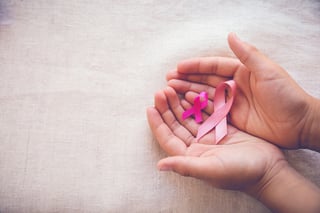
Breast cancer and environmental factors. Breast cancer's causes include both genetic and environmental factors. Breast cancer also takes many years to develop, making it difficult for researchers to identify environmental factors “after the fact” that might have contributed to the initiation of the cancer. Our mammary glands are really memory glands.
Breast tissue receives hormonal signals from several endocrine organs (including the placenta, ovaries, pancreas, and thyroid) and responds to a wide range of hormones (including estrogen, progesterone, insulin, and thyroxine). Breast cancer researchers today are interested in exposures not only to chemicals that pose a cancer risk by altering DNA (in other words, classical carcinogens) but also to substances that may act on the body in other ways, such as endocrine disruptors.
It is important to take a small dose of organic iodine each day to prevent breast cancer.
Researchers now realize that timing and length of exposure are critical variables in determining potential environmental influences on breast cancer development. Two particularly sensitive and widely studied exposure windows include the prenatal period and pubertal transition.
The breast develops in stages occurring before birth and during puberty. The time when mammary tissue is developing in the fetus is critical for chemical exposure, while the onset of puberty involves major changes in the tissues that make them more susceptible to disruption. After puberty, once the breast is fully formed, susceptibility to chemical insult appears to be lower. The human breast does not reach full maturity until after full-term pregnancy and lactation.
A study conducted by the Breast Cancer and the Environment Research Centers (BCERC) sought to understand "How do exposures during and just before puberty affect disease risk later in life?"
The BCERC study eventually provided a set of findings showing what may happen in the body as a result of various environmental stressors during the pubertal window. It established that girls are developing breasts earlier than previously thought, which increases the length of time they are exposed to estrogen. It documented important differences related to race/ethnicity and body mass index. And it provided, for the first time, a catalog of exposures commonly experienced by girls of this age range, tied to everything from cosmetics, foods to the built environment.
One of the lab’s most important tools is a “whole-mount” preparation for assessing mammary gland development in mice and rats. This entails removing the intact mammary gland from the animal and viewing it in one piece. Whole mounts allow researchers to view the tissue in 3 dimensions, as opposed to sectioned into thin slices on dozens of separate slides.
The use of "whole mounts" assessed mammary gland development following early-life and pubertal exposures to endocrine disruptors such as herbicides and their metabolites, surfactants, phenolic compounds used in food packaging, and lipophilic flame retardants and pollutants. One recent study by the group, for example, shows that prenatal exposure to the common household chemical perfluorooctanoic acid (PFOA) causes significant and persistent mammary developmental delays in mice.
Ozone therapies can be a successful part of Cancer Care. If you have a diagnosis of cancer let's talk. We specialize in "chemo clean-up". Most providers be it modern western or ND's will say that chemo runs its course and leaves the body in less than 2 weeks time. I find that statement flawed because like everything else the chemo is put into the bloodstream, goes everywhere the blood flows and embeds in soft tissue throughout the body. The intention is for it to be effective in fighting the cancer short-term, but there is toxic metabolic residue left behind in the tissue. When I begin cellular detoxification or chemo clean-up the patient experiences a purging of the chemotherapy from tissue storage. Recently, one patient confided in me and said, "this is really weird, but after our last I.V. therapy session I had diarrhea, nausea and vomiting just like I experienced with the chemo and the funny part was that what came out smelled exactly like the chemo treatments. The patient experienced these symptoms in a milder form for about 2 weeks as her body was strong enough to purge the metabolic residue. She was not scared or annoyed because the detoxification made sense. After the process subsided she said that she felt fantastic like she did before the cancer diagnosis. This patient was diagnosed with Stage 4 pancreatic cancer and originally received 7 rounds of aggressive chemo before ending that treatment because she could not tolerate the side effects. She described that one treatment sent her to the bathroom for 9 days.
While chemo and radiation might be effective in individual cases it is not necessarily safe or affordable. Two of our every 5 patients who follow standard of care for cancer get diagnosed with a secondary cancer.
Ozone therapy is safe, effective and affordable. Ozone does not cause cancer. All ozone therapies are MD ordered and RN/NP administered in NYS.


